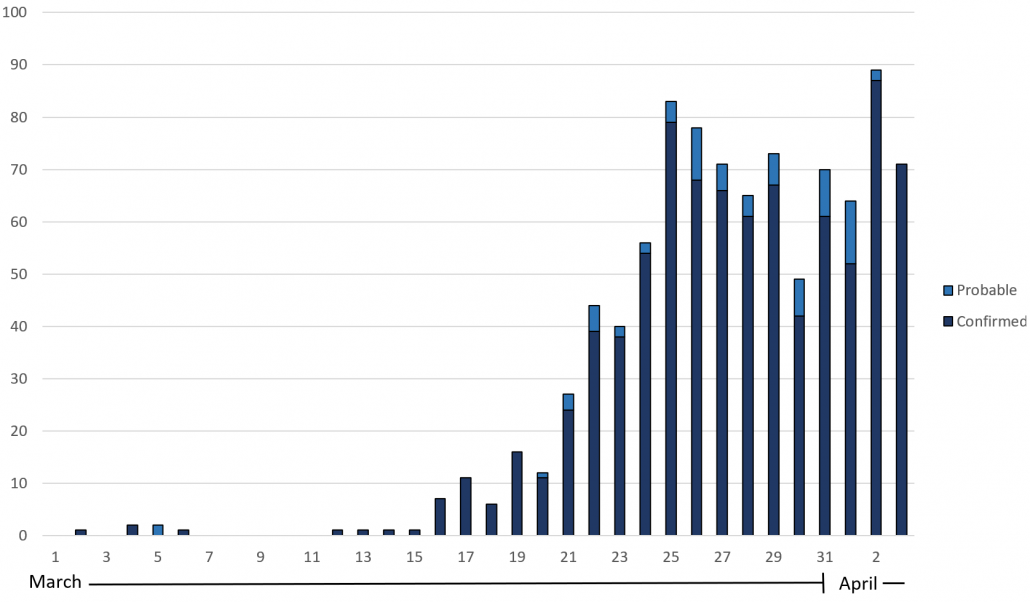After the lockdown
As the costs of regulatory responses to COVID 19 mount, we have developed a framework analyzing which measures governments should adopt, when, and for how long.
How do we plan the next phase of the fight against COVID 19?
As New Zealand begins its second week of lockdown, with only essential services operating, some difficult questions are emerging. The economic pain is mounting, the social impact is enormous, we need to get out of this situation as quickly as we can. How do we know which restrictions to relax first and when? Can we remove the most stringent restrictions a week early? In this thought piece we seek to develop a rigorous method to chart a path out of lockdown.
In case you’ve been living in a bubble for the last two weeks…
The COVID 19 virus is spreading around the world at pace. Expectations for creating a vaccine range from 12-24+ months. Other drugs to treat the virus have potential but are not yet proven and no timeline exists for their production and dissemination. The reported death rates vary from 0.5 percent in places where intensive care is available to 5 percent in places where health systems are overwhelmed. No nation’s medical system has enough capacity to deal with uncontrolled spread due to the speed at which COVID 19 transmits.
Unprecedented actions are being taken as governments around the world make radical regulatory calls to shutdown large swathes of economic activity to limit the spread of the virus. In New Zealand this is called ‘lockdown’ and people are required to stay in their homes except for essential service needs. All non-essential businesses are closed.
The objective of lockdown is to reduce the COVID 19 transmission rate (R) to a manageable level
R is the transmission rate of the virus – it is the speed at which COVID 19 spreads. For each infected person, R is the number of people they will go on to infect. An R greater than 1 means that the virus will grow in the population, an R less than 1 implies the virus will die out.
In the absence of interventions, COVID 19 has an R of approximately 2.5[1]. This means that in the absence of interventions, every infected person would go on to infect 2.5 other people. This is substantially higher than the seasonal strains of influenza[2] that infect large proportions of the world’s population each year.
A manageable level of cases is defined by the capacity of the health system to cope with the case load until a vaccine is developed and distributed (12-24 months). Modelling of outcomes under different response strategies is shown in the chart below.
Figure 1: Epidemic Modelling of the spread of COVID 19 in New Zealand under Mitigation and Suppression Strategies

Source: University of Otago, cited in https://www.nzherald.co.nz/nz/news/article.cfm?c_id=1&object id=12321353
There is evidence emerging that the initial lockdown phase is working to reduce R below 1
In New Zealand, the daily number of new cases appears to have stopped increasing in the past week, as shown in the chart below. Further evidence is required to confirm the new rate of infection under lockdown. At the time of writing, the lockdown appears to be working and the health care system is not overwhelmed. This could change at any time however and in two weeks we will know with more certainty.
There is evidence of suppression measures working in Korea, China, and Taiwan. Analysis of infection rates in Hubei province, China, suggests that R fell to 0.32 during the height of local suppression efforts[3] (though there is some doubt on the reliability of Chinese data[4]). This had led to a substantial reduction in the actual number of people infected in Hubei. This level of effectiveness would be enough to halt the growth of the virus in the population with a significant margin of error.
We will not have to wait long for an empirical understanding of the R that the lockdown measures are achieving in New Zealand. Over the next few weeks, we will have enough observations to determine the trend in our infection rate under lockdown, and thus calculate R. For this piece of analysis, we use 0.32 as an illustrative estimate of what the total impact of our lockdown measures might be. The actual number may be higher or lower, and we will know this soon.
Figure 2: Confirmed and Probable New COVID 19 Cases in New Zealand, 1 April
Source: https://www.health.govt.nz/our-work/diseases-and-conditions/covid-19-novel-coronavirus/covid-19-current-situation/covid-19-current-cases/covid-19-current-cases-details
Stringent public health measures carry enormous economic and social costs
To gain control of the outbreak in the initial phase almost all measures that reduce R should be taken, but the costs of these measures cannot be sustained for long. Lockdown measures carry enormous social costs, losses in productivity, administration costs, and compliance costs. Over time additional costs could emerge as new problems are created in areas such as law and order, domestic violence, mental health, lost educational opportunities, and the like.
There is now a rapidly compounding economic crisis. New Zealand’s GDP may fall by 10 percent in the three months to June, and at the point of lockdown economic activity fell by 40 percent immediately, according to some commercial bank estimates[5]. Not all of these costs can be attributed to the public health measures, however. Some of these costs will be incurred irrespective of the measures the New Zealand Government takes because restrictions imposed by other countries and the severe downturn in the global economy will impact New Zealand in any case.
Undershooting interventions early on carries an enormous economic cost in lives lost, however, overshooting (either maintaining restrictions for too long or imposing them unnecessarily) equally carries enormous economic costs. The magnitude of these impacts necessitates that we have a robust balancing method that is nimble and effective.
To guide decisions, we need a strategy for relaxing restrictions that balances the risk of further outbreaks against social and economic costs
Interventions range from detection and isolation of cases, to public hygiene campaigns, travel restrictions, assembly restrictions and forced closures of businesses and institutions.
We have compiled the following list of potential interventions to reduce the transmission of COVID 19 in New Zealand. This list is not exhaustive. Most, although not all, have been included in the lockdown phase in New Zealand.
Table 1: Potential Interventions to Reduce the Transmission of COVID 19
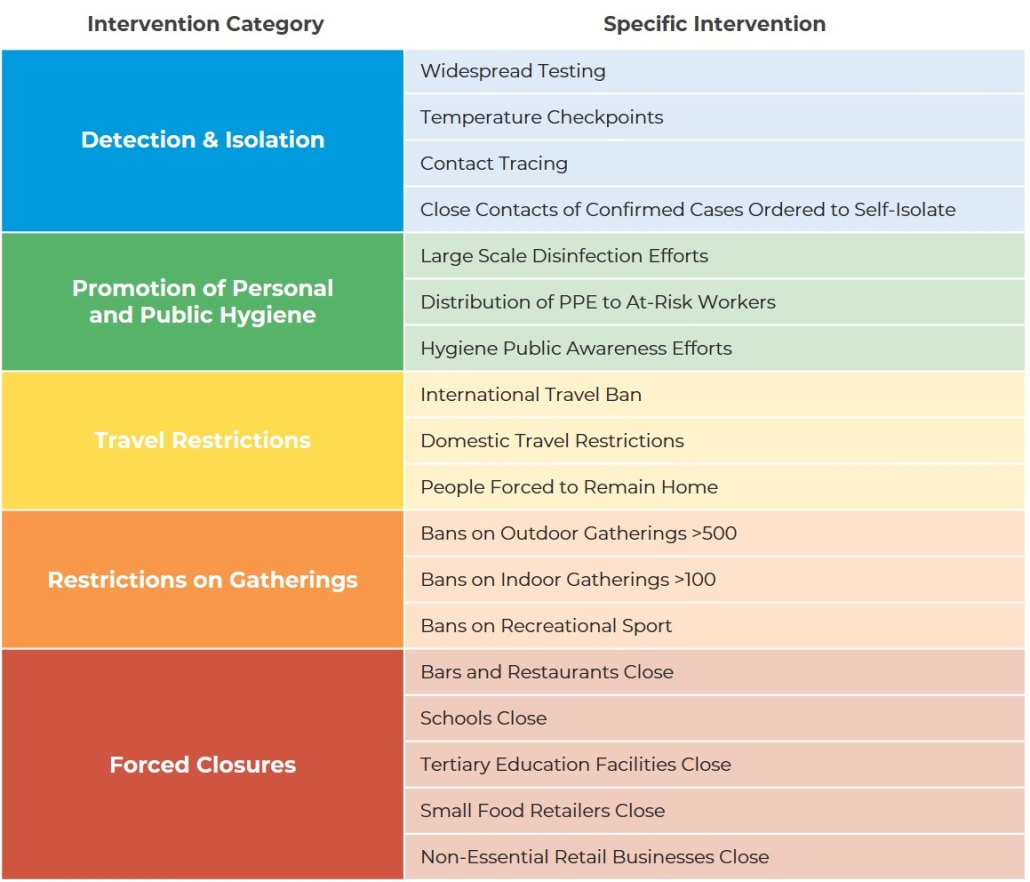
Source: Castalia
Which of these interventions will remain necessary in the next phase?
When we reverse the spread of COVID 19 and reach a manageable number of infected people, the key questions for policy makers will be which of these restrictions can be relaxed and when. The two factors to consider when making these decisions are:
- The impact the restriction has on the transmission rate (R)
- The economic cost of the restriction.
It will make sense to remove the least cost-effective interventions up to the point when R approaches 1. If R can be held at or below 1 then the number of infected people will stay constant or reduce over time. Reducing R substantially below 1 for too long will carry unnecessary cost.
The impact on R and the economic cost of each intervention are not known with certainty at this point but we can make reasonable estimates based on overseas evidence adjusted for New Zealand specific factors.
Evidence of lockdown policies effectiveness are emerging in South Korea, Singapore, Hong Kong and China. Effectiveness of the interventions listed above can be measured as reducing R from 2.5 to 0.32[6] (a change of 2.18). Reducing R to zero would mean a change of 2.5 (but no country has yet reported this). We recognise that there will be cultural differences in the effectiveness of individual measures, but this is an empirical example of the total potential impact of lockdown measures on R.
If we estimate the total potential impact of lockdown measures, then we are primarily concerned with the relative effectiveness of each intervention. Table 2 shows illustrative estimates of the impact of individual interventions on R, scaled so that the sum of all interventions is ΔR 2.18[7]. The interventions were first categorised as having either ‘Low’, ‘Medium’, or ‘High’ effectiveness. We assume that Interventions labelled ‘Medium’ are half as effective as those labelled ‘High’, while those labelled ‘Low’ are half as effective as those labelled ‘Medium’. The largest observed ΔR (2.18) was then split between these interventions in proportion with these defined ratios. The results of this analysis are shown below.
Table 2: Illustrative Estimates of the Impact of Interventions on Transmission Rates
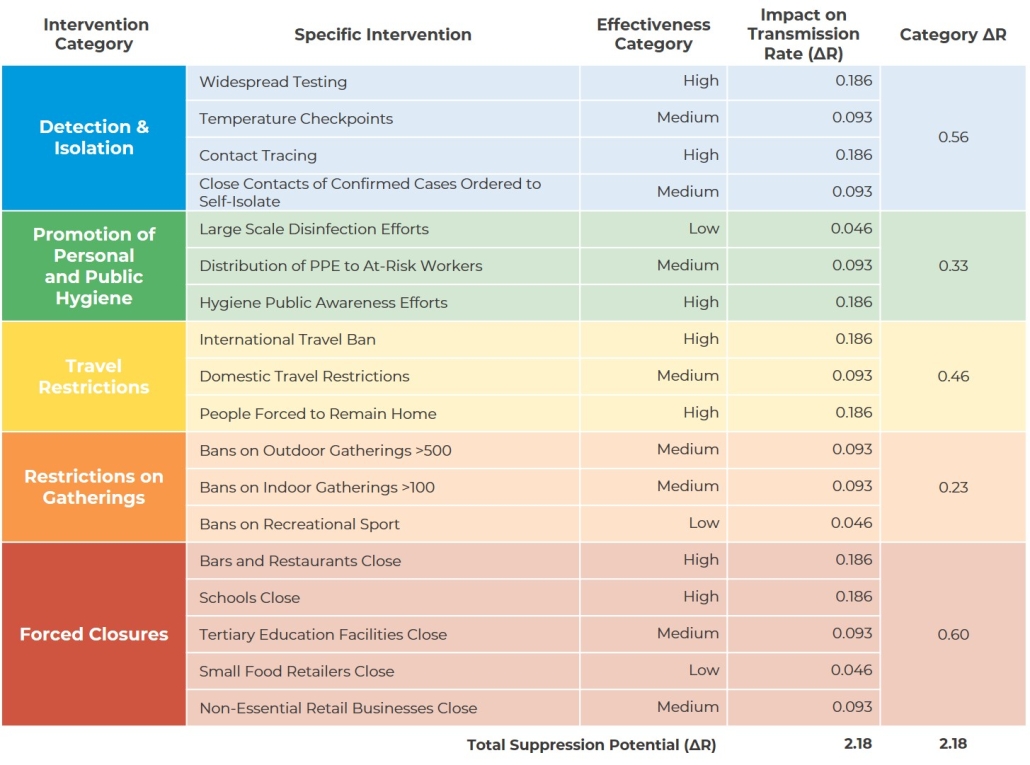
Source: Castalia
Notes: The actual ΔR for each intervention will depend on social, cultural, and geographic factors, meaning that each country is likely to have different results. We would also expect to see learning in each category, meaning that the effectiveness of each intervention should grow over time. We put these estimates forward to start a discussion about their real values in New Zealand. We welcome any empirical evidence or expert judgement that could improve these estimates.
What do these interventions cost us?
Economic costs include all impacts on society including administrative costs, compliance costs, and losses in productivity. It is the broadest measure that seeks to account for all costs – not just observable traded costs. It is not to be confused with financial costs to an individual party as it includes all costs to society, traded and non-traded, irrespective of where they fall.
We are interested in the additional economic cost impact of each intervention and we exclude the costs that will occur anyway (for example costs resulting from reduced foreign demand due to outbreaks in trading partner economies).
We estimated the cost of interventions using categories from 1 (lowest) to 10 (highest). Table 3 shows initial estimates of the cost category each intervention might fall in to. These estimates are based on an initial assessment and carry significant uncertainty.
Table 3: Initial Estimates of the Real Economic Costs and Cost Effectiveness of Interventions
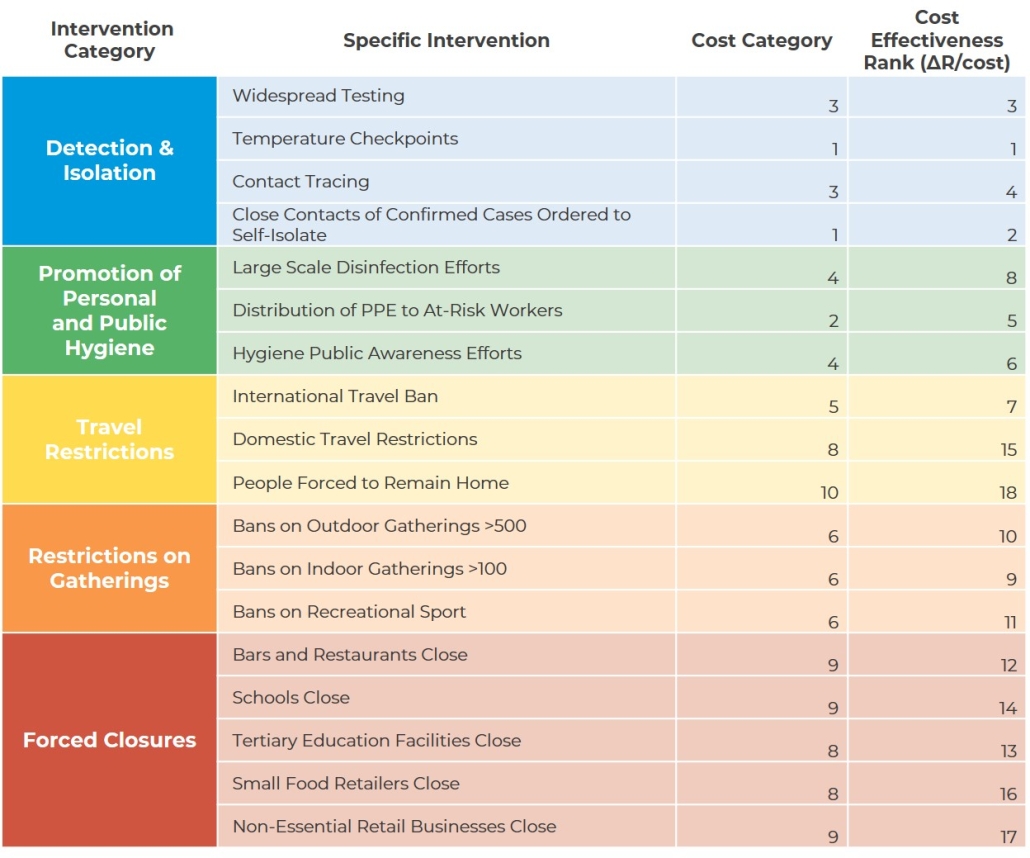
Source: Castalia
Notes: These are initial first estimates of categories of real economic costs, some of which are better understood than others. As with our estimates for ΔR, we put this categorisation forward to start a discussion about the real costs in New Zealand. We welcome any empirical evidence or expert judgement that could more precisely estimate the costs.
The next phase of virus control will involve progressive relaxation of interventions
Ranking interventions by cost-effectiveness, we can identify the interventions that should be relaxed first. The categories of interventions are listed in Figure 3 from those with the highest cost-effectiveness on the left, to those with the lowest cost-effectiveness on the right.
Figure 3: Prioritised Interventions by Category
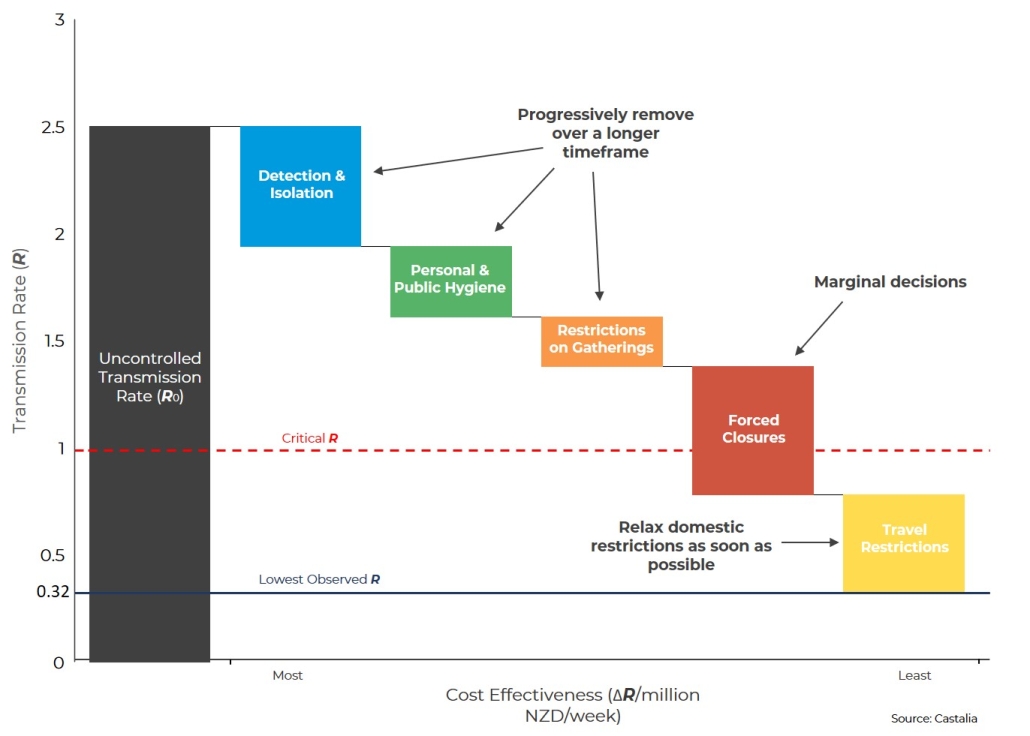
Using this framework, and our initial illustrative numbers, domestic travel restrictions would be eased first, since in this example such a relaxation would not result in exceeding the critical R = 1. Of course, this is illustrative only. The actual cost effectiveness ranking of the various interventions can only be estimated once more data has been gathered and more analysis done.
In conclusion
Our proposed framework, properly applied, can provide a foundation for the difficult policy decisions of if, when and which interventions to relax. To properly apply the framework, we need to gather and assess information on the economic costs of the various interventions. Additional, more in-depth analysis is required before applying the framework to ease any restrictions. If we can get the evidence, then we can use this framework to find the most cost-effective way to protect New Zealanders against the corona virus epidemic.
[1] This is known as the ‘basic reproduction number’ R0. Estimates for the R0 of COVID 19 range between 2 and 3 (James et al., 2020).
[2] Seasonal strains of influenza have an R0 of between 0.9 and 2.1. (see Coburn BJ; Wagner BG; Blower S (2009). “Modelling influenza epidemics and pandemics: insights into the future of swine flu (H1N1)”. BMC Medicine. 7. Article 30.)
[3] https://medium.com/@tomaspueyo/coronavirus-the-hammer-and-the-dance-be9337092b56
[4] The data from China are controversial, and there is evidence that some numbers are unreliable, so it is worth treating the Hubei estimate cautiously. There is, however, reported evidence that the number of new infections in Hubei have fallen since their local peak in January. This means that, by definition, Hubei has been able to achieve an R below 1.
[5] https://www.stuff.co.nz/business/120613593/westpac-forecasts-unemployment-will-climb-by-200000
[6] The lowest reported R.
[7] There are likely to be crowding-out effects between interventions whereby each additional intervention reduces the ΔR of all the other interventions applied. Conversely, as policy makers remove interventions, the ΔR of the remaining interventions will increase marginally. It is therefore reasonable to assume that the ΔR values for each intervention listed in Table 2 is a low estimate, and its effectiveness would increase if other interventions were removed. We have estimated a linear adjustment factor to account for this effect, which we intend to expand upon in subsequent posts.
Image by Fernando Zhiminaicela
About the Authors: Dylan James is a Director in Castalia’s Wellington Office and David Gawith is a Senior Analyst in Castalia’s Auckland office.
Dylan.James@castalia-advisors.com
David.Gawith@castalia-advisors.com
Disclaimer: The views expressed are those of the authors alone. This work has not received funding from any other organisation or interest.
Update: On April 6, this blog post was referenced by NZ Herald in their article about New Zealand’s path out of lockdown.
Update: On April 9, this blog post was referenced by Newsroom in their article about when and how governments should start loosening anti-virus controls.
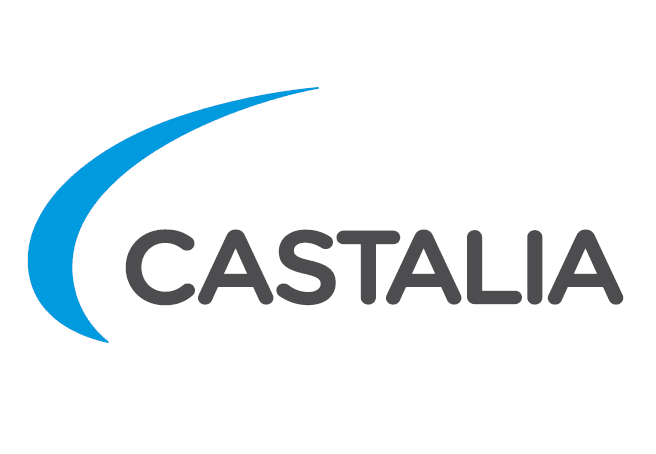
 Image by
Image by 